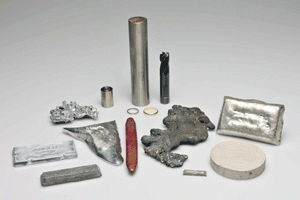Supply “risk list” for rare earth metals published
To coincide with the British Science Festival, the British Geological Survey (BGS) has released a new ‘Risk List’ which ranks the risk to global supply of chemical elements of economic value. The list highlights vulnerable elements where global production is concentrated in a small number of countries, including metals which are critical to development of a low-carbon digital economy.
The risk list helps to focus future research on diversifying supply from new resources, using greener production technologies and cost effective recycling. The new digital and environmental technologies on which we will rely to deliver a prosperous, low carbon economy often contain metals which have previously been of little interest to man. These ‘critical metals’, the celebrities of the periodic table, are completely intertwined with modern life, present in thousands of products and increasingly indispensable.
The BGS Risk List 2011 gives an indication of the relative risk to supply of 52 elements or element groups. Supply risk is estimated using the abundance, production and reserves of the element and governance factors for the producing countries. Critical metals such as tungsten, niobium, rare earths and platinum group elements have the highest supply risk, whilst some industrial metals such as titanium, iron and aluminium have the lowest. The list clearly shows how China dominates global production of minerals and metals, as the leading producer of 27 of the 52 elements listed.
Andrew Bloodworth, Head of Minerals and Waste at the BGS explained, “We need to diversify supplies of metal, especially those critical in delivering the green economy and digital technologies, by finding new resources from the Earth, by recycling more and doing more with less.”
Despite recent scare stories, resources of critical metals, including rare earth elements (REEs), will continue to be available in the Earth. The crustal abundance of REEs is greater than that of silver. Current concerns about REE supply relate to the almost total concentration of production in China and the fact that production of REEs from new mines elsewhere in the world is slow to get going. As a consequence, prices for some REEs have risen very sharply in the last two years.
Professor Frances Wall, Head of Camborne School of Mines (CSM) stated, “There are a wide range of potential deposits around the world that could be mined, which would take away the monopoly of current suppliers of these metals. For example, new research in Malawi carried out by CSM is looking at resources of critical metals associated with rocks known as carbonatites (an igneous form of calcium carbonate).”
The demand for critical metals is relentless. Since the mobile phone came into existence over 9 billion have been made with over 50 million new phones a year each containing an average of 24mg of gold, along with many other metal components. Although recycling these materials has great potential, there are serious concerns that the economic and environmental costs of doing this will outweigh the benefits.
Alan McLelland, Director of the National Metals Technology Centre, NAMTEC, stated “care is needed to look at the form within which these metals are embedded in products and both the energy and environmental impact of their recovery. A holistic view as to the potential recovery of critical metals from product is required and needs to be taken at the outset of their application in order to maximise the potential.”
The Risk List 2011 will was released to coincide with the ‘Metals, Mines & Mobiles’ event at the British Science Festival on the 12th September 2011 at the University of Bradford. The panel of experts at the event examined the life cycle of technology metals and included Professor Frances Wall (CSM), Andrew Bloodworth (BGS), Dr Alan McLelland (NAMTEC) and Dr Paul Mitchell (Director, Green Horizons Environmental Consultants Ltd).
Download the risk list from www.mineralsuk.com






